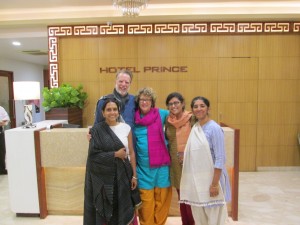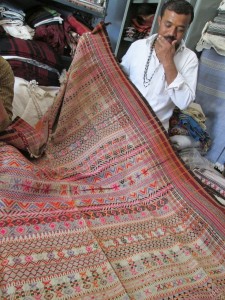Apologies for the radio silence this past week. I was afraid I’d be a bad blogger — unreliable, I mean. And it seems that’s the case. But let me try to give you an overview, and then I can try to fill in more details as the weeks unfold — we’ll be back Sunday! And then will all this feel like a dream?
After a day of recovery (and laundry — ai yi yi!) after our adventure in the Andamans, we flew north to Bhuj, a small city in the Kutch region (or Kachchh in the local dialect!) of the state of Gujarat in northwest India on the Pakistani border. An NGO there, the Khamir Foundation http://www.khamir.org/ is working “to reposition craft and folk music in Kachchh and to revitalize Kachchh’s creative industries.” They hosted us for five days, driving us around the city and local countryside to visit indigenous artisans in their homes and studios. I declared loudly at the start of the first day, “I’m not really in a acquisitive mood at this time in my life, so I hope I won’t offend anyone if I don’t buy their work.” Hah. 30,000 or so roupees later, I have an entirely new appreciation for Indian craft and aesthetic, along with a huge duffel bag of exquisite works.
Day 1: We flew from Bangalore to Mumbai and then onto Bhuj, where the Khamir car met us and took us to the Prince Hotel where we settled in. It was far more commodious than our camp accommodations in the Andamans, with air conditioning, bathrooms and internet in each room, and huge lovely beds. People were so kind and generous, and the food in north India is different and wonderful in an entirely new way from what we’ve been eating in the south. I love them both! We had dinner with Sushma, a high-level contact at Khamir, who oriented us to what we were going to see.
Day 2: We visited two weavers and were treated to private conversations and tours of their studios and workshops. They weave in a local drought-resistant (indigenous) short-staple cotton, in local wools, merino wool, local silk, other long-staple Indian cottons, and combinations of these. They dye with natural colors, including indigo and many other vegetable dyes. The works are mainly varieties of shawls, but Shamji’s family has also won many awards since the 1970s for their designs. The looms are outside and in, and the complexity of the craft is phenomenal.
We had a fascinating conversation with Shamji about contemporary craft and its relationship to contemporary art and design. (insert photo) There is a complex ecology of ideas that I’ll write a separate post about, involving tradition, innovation, sustainability, creativity, family and community networks, and ongoing engagement, local, national, and global markets, and business/commerce. There’s also an IT element, since everyone has a smart phone and is constantly in touch with the rest of the world — these are no longer isolated communities, despite the dust, poverty, and cows, dogs, goats, and camels everywhere on the streets among the autos (three-wheeled open taxis), motorcycles, and cars. The most emblematic statement, “Everything that is true about India is also not true” is everywhere evident.
Day 3: We were introduced to block printing today, another fascinating process with gorgeous products.
Again we visited a master craftsperson, Dr. Ismail Khatri, who taught himself English to educate his many visitors and to learn more himself at a higher level (Shamji’s conversation with us was all through translation). We saw the dye pits, the printing studio, and the selling room, where we purchased liberally. I’ll put in some more photos later — right now, the interface is acting the fool.
Next we visited a young man of 20 who was a block-printer for Dr. Khatri, but the master insisted that the young man go to the local year-long design program to develop his creative skills. He is now working beyond the tradition and into expressive art, but he is ready for a deeper and broader art and design education. We’ll work on finding a way to support him coming to Srishti and/or MassArt for a term if we possibly can — it will require us to find some funds, but it’s entirely within a feasible range and would enrich us and him and the Kutch artisans in many ways. (Photos later I hope!)
Next we visited the Khamir center for lunch and another buying spree — bells, lacquerware, crafts made from plastic bags, and some beautiful embroidery. Then whoosh, off we went back to buy at Dr. Khatri’s, then to another NGO’s office that supported the embroiderers (more buying and a fascinating argument about the needs of contemporary craftspeople beyond the market/commerce solutions), and then out to dinner at a fancy hotel, outside overlooking Bhuj at night. Wooo.
Day 3: Today we saw non-textile crafts — bells, leather, mud-wall painting — and also Rogan textile painting. That is an amazing technique developed by one family who’ve won gazillions of awards internationally. The technique mixes castor oil with pigment to make a gooey paste, which the artisans put on the heel of one hand. Then with a pointed nail, they stretch a string up from the goo gob and lay it in intricate patterns onto the cloth. The framework of the design can be pressed symmetrically onto the other side of the cloth, and then the myriad details are built up, one line/dot/color at a time. They can take 3-6 months each, easily. I bought a “tree of life” with a peacock in the center. Exquisite stuff. Almost unbelievable.
The bell making process was also astonishing, and the bell-maker made a bell in front of us, start to finish. I own it! He cut the scrap metal, sized it carefully, curved it in a stone-hole template, pounded it on a small anvil stick in the dirt, made a top, rounded it, thinned the flanges of bell and top, attached them and pounded, and then off we went to the firing. There, the women pressed clay mixed with cotton fiber into a chapati-like patty, dipped the bell in clay slip and dusted it with copper and zinc, and rolled it into a little biscuit inside the clay. That went into the charcoal fire until the clay got red hot and was then removed to cool, doused with water. When black cool, he cracked the clay with a mallet, revealing the beautiful patina. Then off we went back to the workshop where he put on the clapper and tuned the bell — hammering the bottom and ringing it repeatedly until the overtones rang true and long. Astonishing. We bought a LOT of bells.
Then we drove up north, passing a camel caravan, to a wonderful lunch at a resort created by a village (you can stay there in the fabulous guest houses of mud craft with mud-painting on the walls), and then visited a leather-craftsman and his family. Leathercraft has been in decline, so they’re working on connecting them to designers and building an international market. His wife demonstrated mud painting for us, and we dressed Arzu up in the same kind of finery she wore daily — bangles on lower arms, white bangles stacked without gaps on her upper arms, mirrors and embroidery on her “apron” and a large gathered skirt and metallic-rimmed scarf. Glorious.
We headed to the white desert, where salt accumulates in the dry months to depths 4-6 inches and flamingo flocks pass through on migration. So barren and lovely, even in this pre-salt wetness following the monsoon, and no flamingos. We headed home stopping for a milk curd sweet by the side of the road.
Day 4: Our last day before flying home to Bangalore. We started at the Hunnashala Natural Builders, which is a brilliant architectural group using recycled, local, and natural materials and designs and working to develop local talent by employing youth in apprentice programs. Following that, we visited the bandini (tie-dye) cloth artists, who make phenomenal textiles with intricate dots tied (and paid) one dot at a time. I got a bag of the strings that come off after the dying and drying. Maybe they’ll end up in paper?
We had a thali lunch (20 inch plates and many small dishes) and headed for the airport — flying through Mumbai and then to Bangalore. It was truly an astonishing trip, and it’s clear that we’re just on the beginning edge of understanding the complexities of the lives and challenges of these artisans and their relationships to the international world. Everyone of them is on cell phones constantly, uses computers and the web, and sees visitors from all over the world. Some travel for residencies and exhibitions, and some have been subjects of documentaries and have won stacks of prizes. It’s not the isolated world of rural India that it used to be — but superficially, it has much of that veneer. The future is a dynamic process, and ensuring that it goes well for the artisans is a cause Khamir is dedicated to. I’m in awe.




December 22, 2023 at 5:00 am
Data HK yaitu ringkasan yang membahas tentang hasil result pengeluaran data hk atau togel Hongkong yang sudah terlewatkan. Kata kunci ini sendiri banyak di cari-cari oleh pemain yang meminati Hongkong Pools. Jika kamu salah satu pecinta pasaran hongkong pools dengan demikian situs ini pilihan yang tepat bagi anda. Sebab kami akan tampilkan pengeluaran HK pools terbaru dan tercepat khusus bagi yang membutuhkan.
December 26, 2023 at 4:48 am
Lagi cari Jasa Live Streaming atau Dokumentasi Foto dan Video? Jangan khawatir, kini ada Letari Studio yang menawarkan
layanan Jasa Live Streamind juga Dokumentasi Foto dan Video untuk Event dan Wedding Anda.